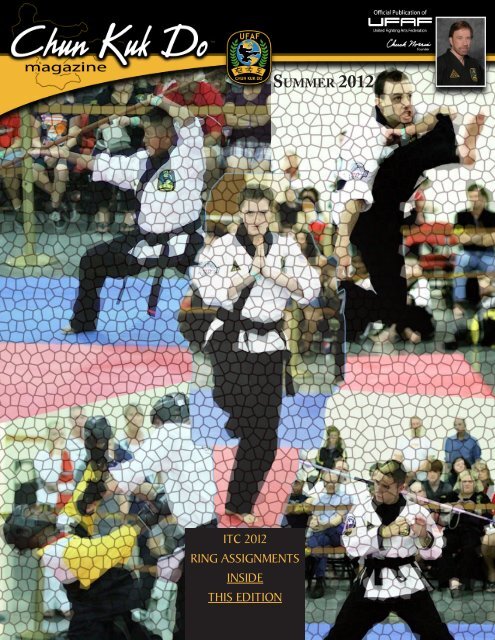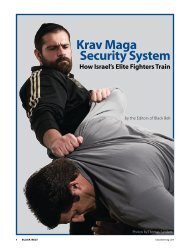2012_Summer_Chun Kuk Do Magazine - Danny Lane
2012_Summer_Chun Kuk Do Magazine - Danny Lane
2012_Summer_Chun Kuk Do Magazine - Danny Lane
You also want an ePaper? Increase the reach of your titles
YUMPU automatically turns print PDFs into web optimized ePapers that Google loves.
ITC <strong>2012</strong><br />
RING ASSIGNMENTS<br />
INSIDE<br />
THIS EDITION<br />
<strong>Summer</strong> <strong>2012</strong>
United Fighting Arts Federation Mission Statement<br />
The United Fighting Arts Federation (UFAF) is dedicated to<br />
providing and facilitating quality martial arts instruction,<br />
leading to the most prestigious black belt ranking certifications<br />
in the martial arts world.<br />
Through the disciplined, internal growth of its membership and<br />
the development of world class teaching ability and leadership<br />
within its ranks, UFAF seeks to make <strong>Chun</strong> <strong>Kuk</strong> <strong>Do</strong> one of the most<br />
recognizable and respected martial arts styles in the world.<br />
Building on these principles, UFAF is committed to assisting<br />
its member schools in providing a quality martial arts training<br />
experience to every student of <strong>Chun</strong> <strong>Kuk</strong> <strong>Do</strong>, and to enriching and<br />
serving the communities in which it is represented by cultivating<br />
high character in the lives of its members.<br />
About the United Fighting Arts Federation<br />
The United Fighting Arts Federation (UFAF) is a worldwide<br />
martial arts membership organization founded by Mr. Chuck<br />
Norris which provides its member students, instructors, and<br />
schools with <strong>Chun</strong> <strong>Kuk</strong> <strong>Do</strong> (CKD) rank certification, educational<br />
opportunities, <strong>Chun</strong> <strong>Kuk</strong> <strong>Do</strong> news, special events, online<br />
community access, and other services. UFAF is the governing and<br />
sanctioning body for the <strong>Chun</strong> <strong>Kuk</strong> <strong>Do</strong> style, providing technical<br />
standards for instruction and advancement in the system.<br />
About <strong>Chun</strong> <strong>Kuk</strong> <strong>Do</strong><br />
<strong>Chun</strong> <strong>Kuk</strong> <strong>Do</strong> (CKD) is an American martial arts style, evolved from<br />
Korean Tang Soo <strong>Do</strong> by Chuck Norris. <strong>Chun</strong> <strong>Kuk</strong> <strong>Do</strong> (“The Universal<br />
Way”) is a style with a deeply-rooted traditional foundation into<br />
which many other elements that complement its fundamentals<br />
have been integrated. <strong>Chun</strong> <strong>Kuk</strong> <strong>Do</strong> has come to emphasize self<br />
defense, competition, weapons, grappling, fitness, and more.<br />
With <strong>Chun</strong> <strong>Kuk</strong> <strong>Do</strong>, the martial arts world is an open door.<br />
CKD <strong>Magazine</strong><br />
Melissa Biernacinski- Editor-in-Chief, melissa.ufaf@gmail.com<br />
Steve Nelson- UFAF Advisor, office@ufaf.org<br />
Steve Brown- UFAF Marketing & Branding, sbrown@ufaf.org<br />
Jacob Sherman- Publication Design, jacobsherman1@verizon.<br />
net<br />
Article Submissions:<br />
E-mail article ideas and photographs (300dpi, jpg or tif) to<br />
Melissa Biernacinski- Editor-in-Chief, at melissa.ufaf@gmail.<br />
com.<br />
Deadlines:<br />
Spring Publication - Deadline is December 1<br />
<strong>Summer</strong> Publication - Deadline is April 1<br />
Fall Publication - Deadline is August 1<br />
The United Fighting Arts Federation; UFAF, Inc.; KICKSTART; and/<br />
or CKD <strong>Magazine</strong> are not responsible for physical or personal<br />
injury, either directly or indirectly, from any materials published<br />
herein. We do not endorse and make no representation,<br />
warranty or guarantee concerning the safety or effectiveness of<br />
either the products and services advertised in this magazine or<br />
the martial arts or other techniques discussed or illustrated in<br />
this publication. All rights in letters, articles, and photographs<br />
sent to CKD <strong>Magazine</strong> will be treated as unconditionally assigned<br />
for publication and copyright purposes. Subject to unrestricted<br />
right to edit and comment editorially.<br />
2 CKD <strong>Magazine</strong> | <strong>Summer</strong> <strong>2012</strong><br />
Having been<br />
raised in<br />
California,<br />
I had the<br />
opportunity<br />
on occasion to<br />
experience the beauty and the splendor<br />
of the migration and the clustering of the<br />
monarch butterfly in Monterey, California.<br />
If you have experienced this in your<br />
lifetime, it is an experience one does not<br />
forget.<br />
The monarch butterfly (Danaus plexippus)<br />
is a widespread tropical insect that ranges<br />
as far north as Canada and as south as the<br />
high mountains of Central Mexico. The<br />
monarch cannot stand freezing winter<br />
temperatures. To survive, it must migrate<br />
to safe over-wintering sites that are neither<br />
cold enough to kill it nor so warm that it<br />
wastes precious energy flying to a cooler<br />
climate. En route, they may travel as much<br />
as 2,000 miles, covering up to 100 miles per<br />
day and flying as high as 10,000 feet. This<br />
is a mighty achievement for a seemingly<br />
fragile insect.<br />
One of the things that is unique about this<br />
migration versus other migrating species<br />
like birds and whales, is the monarch<br />
has never seen its destination before. I<br />
would encourage all to visit Pacific Grove,<br />
California (Butterfly Town, USA) in<br />
October. You will thank me later.<br />
So how does this apply to United Fighting<br />
Arts Federation and <strong>Chun</strong> <strong>Kuk</strong> <strong>Do</strong>?<br />
Like the monarch, UFAF and CKD<br />
have, and continue to go through, change<br />
and metamorphosis. It is said that “One<br />
cannot become a butterfly by remaining a<br />
caterpillar.” Change and personal growth<br />
is about discovering the inevitability<br />
of change, and a process of repeating<br />
change, so we can continue to progress.<br />
The monarch needs nutrition both in its<br />
larval stage, and its caterpillar stage, from<br />
the milkweed plant. Just like the nutrition<br />
given to the monarch, our <strong>Chun</strong> <strong>Kuk</strong><br />
<strong>Do</strong> training provides us the nutrition for<br />
growth at every stage of our training.<br />
Letter from our President<br />
Mr. Ken Gallacher<br />
In the beginning, we receive training in our<br />
schools and at UFAF functions to help us<br />
explore all aspects of martial arts training<br />
as provided by our CKD instructors and<br />
special guest trainers. Incredible articles,<br />
written by current practitioners, that are<br />
current and relevant to what’s occurring<br />
today in our art and throughout the world<br />
help guide us on our migration to success.<br />
As we progress, we continue to receive<br />
great ideas and training to help us soar<br />
to the greatest height possible. We have<br />
our current schools, regional seminars,<br />
Instructor Development Series (IDS),<br />
Master Development Series (MDS), and<br />
the International Training Conference<br />
(ITC), which includes a world class<br />
tournament.<br />
One of the things that is unique about<br />
the diet of the monarch is that the diet<br />
itself protects the butterfly as well as the<br />
growing larvae from its natural predators.<br />
While training in the martial arts, we also<br />
have natural predators of discouragement,<br />
outside internal/external change and, just<br />
like the monarch, our diet of education,<br />
connecting with others, and involvement<br />
in all of the training UFAF has to offer<br />
provides for us a natural protection.<br />
These things help bring us out of our cocoon<br />
and reach our maximum potential. But you<br />
must metamorphose in order to change and<br />
that involves going through discomfort of<br />
being less and less a caterpillar while you<br />
are in the process of becoming a butterfly.<br />
Expect the transformation to be somewhat<br />
uncomfortable and that it takes a level of<br />
commitment.<br />
As we move forward, I wish each of you all<br />
the splendor and beauty that comes from<br />
our unique metamorphosis and migration<br />
as is afforded the monarch butterfly.<br />
Sincerely,<br />
Ken Gallacher, 9th Degree Black Belt<br />
President, United Fighting<br />
Arts Federation<br />
Past editions of CKD <strong>Magazine</strong> online http://ckdm.ufaf.org/<br />
Contents<br />
<strong>Summer</strong> <strong>2012</strong>....................................................................1<br />
Letter from our President....................................................2<br />
Editor’s note.......................................................................3<br />
Annual ITC boasts new offerings,<br />
world-class headliners and more.......................................4<br />
Tips for visiting Las Vegas:<br />
from a Las Vegas native..................................................5<br />
Varying teaching techniques can<br />
allow all students to thrive ................................................6<br />
CKD schools doing something good: Presti Karate...............7<br />
For more than 30 years, Ms. Diane Huntemann<br />
has taught by example.......................................................7<br />
Some sad news..................................................................7<br />
Drill of the issue: Fail so you can improve...........................8<br />
Team CKD news...............................................................12<br />
REGION~NEWS.......................................................13~21<br />
Testing/promotion requirements<br />
Part 3: a teaching/learning resource.................................15<br />
ITC <strong>2012</strong> Ring Assignments......................................22~23<br />
ChuCk Norris FuN FaCts<br />
Chuck Norris can drown a fish.<br />
Chuck Norris decides whether Santa’s been naughty or nice.<br />
When Chuck Norris watches a pot, it boils.<br />
Chuck Norris never wore braces.<br />
He straightened his own teeth.<br />
UFAF Shop online- http://www.ufaf.org/shop.htm<br />
Editor’s note<br />
As I was putting together this issue of<br />
CKD <strong>Magazine</strong>, my first issue as its<br />
editor, I was also preparing for my 3rd<br />
degree black belt test and assisting with<br />
the creation of written materials for the<br />
ITC. To say my personal life was “all<br />
karate, all the time” for a while would<br />
have been pretty accurate.<br />
As I was gearing up for my big test, I spent a lot of time at the<br />
neighborhood park practicing my forms. One evening, after making<br />
mistake after mistake on the bo form, I found myself thinking, “This<br />
is so frustrating! Why am I doing this again?” Of course, anyone<br />
reading this knows the answer to that.<br />
Not just anyone can (truthfully) say they’ve earned a black belt.<br />
Achieving a black belt takes work – repetition, discipline, attention<br />
to detail. It takes vision, as anyone who begins as a white belt with<br />
the honest goal of black belt knows. It takes perseverance; for many<br />
on the road to black belt, there will be hurdles to overcome – injuries,<br />
school demands, work demands, family obligations, etc. Overall, it<br />
can be frustrating and it can be crazy. But, you know what? I wouldn’t<br />
have it any other way.<br />
It’s those achievements that take work – hard work – that usually<br />
mean the most. And, it’s those trying hurdles – once overcome – that<br />
are remembered most fondly.<br />
Plus, how awesome is it to say, “I’m a black belt”?<br />
Whether you’re a white belt or a master-rank black belt, I salute you<br />
for your vision and dedication to our art. And, to those who passed a<br />
recent belt test, congratulations!<br />
Sincerely,<br />
Melissa Rothermel Biernacinski<br />
Editor-in-Chief<br />
Crazy story: Century Martial Arts Supply CEO<br />
and CKD black belt Mike Dillard encounters<br />
adventure, danger in Indonesia<br />
“Mike Dillard, chief executive officer of Century Martial Arts and a<br />
prominent area developer, is a well known adrenaline junkie — but<br />
even he admits he was shaken by his latest adventure. …”<br />
Read the entire story, as told by NEWSOK, here.<br />
CKD <strong>Magazine</strong> | <strong>Summer</strong> <strong>2012</strong> 3
Annual ITC boasts new<br />
offerings, world-class<br />
headliners and more<br />
As this year’s ITC approaches, <strong>Chun</strong> <strong>Kuk</strong> <strong>Do</strong> practitioners have much<br />
to look forward to. Themed “Ask me about my bruises,” the ITC will<br />
take place in Las Vegas Thursday through Sunday, July 19-22.<br />
Kicking off with the MRIC, followed by a pool party and BBQ, the<br />
evening of July 19, the convention and related festivities will take<br />
place at the South Point Hotel & Casino, which is located at 9777<br />
Las Vegas Blvd South, just minutes away from the famous Las Vegas<br />
Strip.<br />
Celebrating its 34th year, the ITC has seen a number of upgrades<br />
this year, including an inaugural KidTC. Geared toward youth ages<br />
8-12, the KidTC will have its own look and feel, headliners and lineup<br />
throughout the seminar portion of the convention.<br />
“Our youth are an important part of UFAF, and we believe the KidTC<br />
will enhance their ITC experience,” said John Presti, UFAF’s director<br />
of special events.<br />
The CKD World Championship tournament, however, will continue<br />
as a single event for all ages.<br />
As always, the ITC will feature world-class martial artists. Headlining<br />
the event this year are:<br />
•Iain Abernethy, a 6th dan with the British Combat Association,<br />
the English Karate Federation and the British Karate Association<br />
•Jadi Tention, a six-time world champion and a 5th degree black<br />
belt in Tae Kwon <strong>Do</strong> and a black belt in Nashid and Kurishi <strong>Do</strong><br />
•David Meyer, one of the first Americans to achieve the black belt<br />
rank Brazilian Jiu Jitsu<br />
•John Comito, CKD 5th degree black belt and member of<br />
Pambuan Arnis<br />
•Joe Gemma, CKD 8th degree black belt and retired Las Vegas<br />
Metropolitan Police Department Lieutenant<br />
4 CKD <strong>Magazine</strong> | <strong>Summer</strong> <strong>2012</strong><br />
By Melissa Biernacinski<br />
3rd degree black belt<br />
Another first for the ITC this year is a grappling division for all ages.<br />
“With the growth of our grappling program, our ISDT and how many<br />
schools are doing more and more grappling, it was time to expand,”<br />
Mr. Presti said. “Depending on how popular it becomes, it may grow<br />
and expand in time.”<br />
In addition to the grappling division, the competition portion of the<br />
convention will include a kata competition and team and individual<br />
sparring competitions.<br />
The annual awards dinner will take place Friday evening, July 21.<br />
Open to family members and friends, the dinner will feature UFAF<br />
and <strong>Chun</strong> <strong>Kuk</strong> <strong>Do</strong> Founder and Chairman Chuck Norris, who will<br />
give a speech. UFAF CEO Aaron Norris and UFAF President Ken<br />
Gallacher will also present. Additionally, awards including School of<br />
the Year, Instructor of the Year, Competitor of the Year (female and<br />
male), Most Inspirational Member and the Wieland Norris Award,<br />
will be presented and those advancing to the master ranks will be<br />
recognized.<br />
“ Our youth are an<br />
important part of UFAF,<br />
and we believe the KidTC<br />
will enhance their ITC<br />
experience.<br />
”<br />
Prior to the ITC’s official start, a Master Development Series 501<br />
course will take place at the Henderson, Nev.-based Cox & Gallacher<br />
Karate studio Monday and Tuesday, July 16 and 17. The following<br />
Monday and Tuesday, July 23-24, MDS 502, 601 and 602 courses will<br />
be held at the South Point.<br />
Recommended for all black belts, the goal of the Master Development<br />
Past editions of CKD <strong>Magazine</strong> online http://ckdm.ufaf.org/<br />
Series program is to have a pervasive, positive<br />
and unifying effect throughout UFAF on what<br />
and how black belts learn and teach; to inform,<br />
instruct and inspire all who attend to be the<br />
very best they can be; and to give them tools<br />
to do the same for their students.<br />
Black Belt attendees may also register to take<br />
part in the Professional Development Series<br />
Wednesday and Thursday, July 18 and 19, and<br />
red and black belts can also sign up for the<br />
Instructor Development Series, which will be<br />
held Thursday, July 19.<br />
Mr. Abernethy will teach the entire IDS<br />
workshop, themed “Making kata come alive<br />
for students.” The PDS workshop, themed<br />
“The business of martial arts,” is geared toward<br />
school owners and black belt instructors and<br />
will include presenters such as UFAF CEO<br />
Aaron Norris and UFAF President Ken<br />
Gallacher. The PDS and IDS events will take<br />
place at the South Point Hotel.<br />
For additional details, including cost, and<br />
to register for the MDS, IDS and PDS<br />
workshops, visit www.ufaf.org.<br />
For more information on the entire ITC, visit<br />
www.ufaf.org. Hotel information (including<br />
the group code), black belt dress uniform<br />
details and more can also be found on UFAF’s<br />
website.<br />
UFAF Shop online- http://www.ufaf.org/shop.htm<br />
Tips for visiTing<br />
Las vegas: from a<br />
Las vegas naTive<br />
By Melissa Biernacinski<br />
1. Thou shalt wear sunblock at all times! I can’t<br />
tell you how many tourists I’ve seen who are<br />
sunburned. It looks painful as is; now imagine<br />
putting a karate uniform over it. Ouch!<br />
2. If there’s an activity you love to do, chances<br />
are you can do it here. Just a few options<br />
include golfing, world-class shopping, fine<br />
dining, skydiving, hiking and even helicopter<br />
riding. <strong>Do</strong> your research ahead of time to find<br />
an attraction that suits you.<br />
3. Speaking of activities, discounts on restaurants<br />
and shows are available. Visit tix4tonight.<br />
com and tix4dinner.com to find out more.<br />
4. Like beauty? Visit the Bellagio fountains (out<br />
front) and atrium (indoors) for some lovely free<br />
entertainment.<br />
5. Saving money is good. Rather than taking<br />
a taxi from the airport, take advantage of the<br />
South Point’s free shuttle service. Reservations<br />
are required and can be done by calling<br />
1-866-791-7626 (toll-free) at last 24 hours in<br />
advance. For the shuttle schedule, visit southpointcasino.com/hotel/shuttle-schedule.php.<br />
6. If you tend to get cold, bring a sweater. To<br />
offset Las Vegas’ high temperatures, most<br />
hotels, restaurants and movie theaters turn<br />
the AC to near-freezing temperatures.<br />
7. And finally, Las Vegas is hot and dry, so drink<br />
lots of water!<br />
CKD <strong>Magazine</strong> | <strong>Summer</strong> <strong>2012</strong> 5
Varying teaching<br />
techniques<br />
can allow all<br />
students to thrive<br />
Because Every Student Matters …<br />
Sadie Nicole Houck (Robinson)<br />
2nd degree black belt<br />
As a special education teacher, I know<br />
firsthand the adversity students with<br />
disabilities face on a daily basis. It is my job<br />
as a teacher to guide them and assist them in<br />
becoming successful individuals while pushing<br />
them to meet their goals. It is also my job to<br />
assist other teachers in presenting material in<br />
such a way that all students can be successful.<br />
As a <strong>Chun</strong> <strong>Kuk</strong> <strong>Do</strong> school owner, I would like<br />
to share the following information and ideas to assist fellow school<br />
owners, instructors, assistants and other leaders in <strong>Chun</strong> <strong>Kuk</strong> <strong>Do</strong><br />
schools, especially our youth.<br />
Today, one in 88 American children has some form of autism spectrum<br />
disorder. At least one out of every five people in the United States has<br />
a learning disability. There is a 50 percent chance that a child born to a<br />
parent with dyslexia will also have dyslexia.<br />
The question is, how do we prepare ourselves, to instruct to the best<br />
of our abilities, while trying to reach all students – from students with<br />
disabilities to students who are gifted?<br />
We must first develop classes that allow students of different abilities<br />
and different ranks to work together. It was thought years and years<br />
ago that students with disabilities should have their own class or<br />
special school and should not be with the “other” students. In the mid-<br />
70s, there was an estimated 1 million students with disabilities who did<br />
not even attend school. Allowing students of all abilities to take class<br />
with one another has many benefits: It improves the learning of all<br />
students; students learn to accept individual differences and advocate<br />
6 CKD <strong>Magazine</strong> | <strong>Summer</strong> <strong>2012</strong><br />
for themselves and others; students new friendships, leadership<br />
qualities and compassion; and students don’t feel left out.<br />
I once read, “Fair isn’t when everyone gets the same thing. Fair is when<br />
everyone gets what he or she needs!” To assist every student in getting<br />
what he or she needs, we have to have an understanding of how to<br />
differentiate and improve instruction.<br />
Here are some examples:<br />
• Provide a variety of “drills” or “tasks” to teach one concept.<br />
• Vary the degrees of difficulty of your drills.<br />
• Get to know what type of learners your students are.<br />
• Instruct in a way that reaches every type of learner: auditory,<br />
visual and kinesthetic learners.<br />
• Allow students to set group goals and individual goals.<br />
• Give students opportunities to demonstrate proficiency in an<br />
area they currently understand and allow them to move forward.<br />
• Be open to varying your assessment protocols.<br />
• Demand choral responses when reviewing material you want<br />
every student to know.<br />
• Use the “I do, we do, you do” method. (For example: when<br />
presenting a new drill, first show the students how to do the<br />
drill. Then, have the students practice with you. Finally, have the<br />
students do the drill on their own.)<br />
Past editions of CKD <strong>Magazine</strong> online http://ckdm.ufaf.org/<br />
CKD schools doing something good: Presti Karate<br />
By <strong>Do</strong>ug Boje<br />
3rd degree black belt<br />
Sometimes the greatest things in life have the most humble beginnings. Fourteen years ago, Mr. John<br />
Presti hosted a kids’ karate tournament at his school in Niagara Falls, NY. It was an opportunity for kids<br />
to have fun and get the chance to win a trophy. Little did he know at the time that this tournament would<br />
become the largest kids’ karate tournament in New York. Since its inception, the tournament has raised<br />
thousands of dollars for those less fortunate and makes a powerful difference in the lives of people who<br />
need it most.<br />
The Presti Kids’ Karate Tournament has raised $82,000 dollars over the last 12 years – no small feat<br />
considering the economy of late and the location of Mr. Presti’s studio. Even though Niagara Falls is<br />
known throughout the world, it is not as affluent as other areas in Western New York. So how was it<br />
done? It took a community effort of local businesses, parents, volunteers and countless martial artists.<br />
Numerous black belts travel great distances to help with the event. This year, they came from West Virginia,<br />
Pennsylvania, Canada and Buffalo and Rochester, NY. Besides <strong>Chun</strong> <strong>Kuk</strong> <strong>Do</strong>, styles range from Tae Kwon<br />
<strong>Do</strong> to Bushido Kai. This showing from so many is truly indicative of the character that these martial artists<br />
have to make a difference. This difference helps those less fortunate and helps kids realize how dedicating<br />
themselves to a sport can have rewards beyond trophies and medals.<br />
It starts with Mr. Presti, who has always been proactive in maintaining the integrity of the martial arts in<br />
the area. He is a member of the Professional Martial Arts Educators, a group of school owners who watch<br />
to see what is going on in the community. Members support one another in various tournaments and<br />
encourage their students to attend others’ events.<br />
For more than 30 years, Ms. Diane Huntemann<br />
has taught by example<br />
By Sadie Nicole Houck (Robinson)<br />
2nd degree black belt<br />
“People never improve unless they look to some standard or example higher<br />
and better than themselves.” –Tyron Edwards<br />
Ms. Diane Huntemann is one of those examples. Currently an 8th<br />
degree black belt, Ms. Huntemann received her 1st degree black belt in<br />
1982 in Los Angeles with Mr. Chuck Norris himself running the exam.<br />
As instructed by Mr. Bob<br />
Barrow (Black Belt #22), Ms.<br />
Huntemann was required as a red<br />
belt to assist with classes. Once<br />
a black belt, she began to teach<br />
more and more. Ms. Huntemann<br />
was and is no stranger to being<br />
a great example for those around<br />
her.<br />
About 10 years ago, while<br />
teaching an advanced class,<br />
Ms. Huntemann remembers a<br />
UFAF Shop online- http://www.ufaf.org/shop.htm<br />
particular moment where she<br />
was being “watched”: One of<br />
her students had just moved<br />
into town and had brought her<br />
2-year-old daughter, who was<br />
asleep in her stroller, to class that<br />
evening.<br />
“During class, while I was making<br />
some point, I felt something glom<br />
onto my leg,” Ms. Huntemann<br />
recalled. “I looked down and saw<br />
this creature, wearing some sort<br />
ITC 85’ (Ms. Huntemann)<br />
of leopard-print fairy princess<br />
outfit. She had woken up and,<br />
thinking I was her mother,<br />
staggered out onto the floor, still<br />
half-asleep.”<br />
Who would have ever guessed<br />
that the awoken princess would<br />
one day find herself receiving her<br />
1st degree black belt?<br />
some sad news<br />
A member of our UFAF<br />
family, 1st degree black<br />
belt Jeff Rubin, passed<br />
away Feb. 13. Mr. Rubin,<br />
black belt number<br />
1170, was a member<br />
of UFAF for the past 18<br />
years. Recently, he had<br />
begun sharing his martial<br />
arts expertise with the<br />
Las Vegas senior citizen<br />
community. He will be remembered<br />
for his always<br />
friendly countenance and<br />
his gentle and generous<br />
spirit.<br />
He is survived by his<br />
loving wife, Cordella;<br />
stepdaughter, Dawn; his<br />
devoted mother, Marlene;<br />
his brother Paul; sisterin-law,<br />
Katie; nephew,<br />
Benjamin; niece, Juliette;<br />
and many aunts, uncles,<br />
and cousins.<br />
He will be sorely missed<br />
by all.<br />
CKD <strong>Magazine</strong> | <strong>Summer</strong> <strong>2012</strong> 7
Drill of the issue:<br />
Fail<br />
improve<br />
so you can<br />
By Steve Brown<br />
5th degree black belt, Current CKD Men’s Heavyweight Fighting World Champion, 2011 UFAF Instructor of the Year<br />
s humans, we tend to learn the most through our failure. Of course, no one likes to fail, but beginners, in anything, experience some degree of failure, then learn and improve.<br />
A<br />
Many martial artists are guilty of reaching a plateau and settling in to what is comfortable, avoiding failure, both as students and instructors. Many of our training techniques<br />
are stagnant and never evolve beyond that of what we first learned, and so many are guilty of embracing that basic level of training as the end all and never realizing that was just<br />
one of the first steps in a long staircase.<br />
Let’s take a look at something we have all done … standing front kick with the rear leg on a body shield. Probably the first kick you ever learned. You came to class, you stood in<br />
your best fighting stance, the instructor guided you and adjusted the pad to be the perfect distance, and you concentrated on all the details you were taught to do the perfect thrust<br />
kick: load the leg with the knee high, thrust the kick forward, extend and release, pushing the ball of the foot into the target, recoil the leg with the knee high, set down with control,<br />
not falling forward, and repeat. Some of these kicks didn’t quite hit center. Some knocked you off balance. Some felt awkward. In other words, some were failures. You improved,<br />
auto-correcting every time, getting faster, stronger, learning from your failures as you tried to recreate the successful kicks.<br />
Now, you’re a green, red or even black belt. You get a partner and a pad, get in your best fighting stance, your partner squares off and gets ready and wham! You crush a front kick,<br />
again and again. After an impressive set of 10, you feel quite confident in the awesome power of your front kick and smirk as your partner tells you how you almost took the wind<br />
out of him through the pad. But wait … where was your failure? Where was the struggle to improve? You’ve taken a gold or purple belt pad drill to its limit; you’ve reached the<br />
plateau and it’s comfy there. It’s time to make you uncomfortable. Congratulations black belt; you’re a really good purple belt.<br />
So here’s the progression, or stages, you can go through in our pad drill example: static kicker/static pad holder; static kicker/dynamic pad holder; static kicker/dynamic pad holder<br />
(forcing failure about 30 percent of the time); dynamic kicker/dynamic pad holder; dynamic kicker/dynamic pad holder (forcing failure about 30 percent of the time).<br />
It goes like this:<br />
Static kicker/static pad holder - Beginner<br />
Regardless of rank, this is where you<br />
start with any new kick or skill when<br />
first learning it. Everything is controlled;<br />
both kicker and pad holder are stationary<br />
allowing the kicker to learn, adjust<br />
and improve the principles of the<br />
kick (posture, lines of power, methods<br />
of generating power, etc.) safely and<br />
consistently, building muscle memory<br />
and confidence. The “failure” factor is built<br />
in automatically through the beginner’s<br />
inexperience. Practice this way until you<br />
develop confidence with the kick, having<br />
consistency with technique and generating good power nine or 10 out of 10 times.<br />
Static kicker/dynamic pad holder – Beginner/Intermediate<br />
Apparently, the bullies and muggers of the world didn’t get the memo that they were supposed to stand still when we kick them. Now we<br />
introduce a new variable, the moving target. Our kicking is still done from the controlled static position, so we continue to develop our<br />
8 CKD <strong>Magazine</strong> | <strong>Summer</strong> <strong>2012</strong><br />
Past editions of CKD <strong>Magazine</strong> online http://ckdm.ufaf.org/<br />
technique, but now the element of external timing is introduced. The pad holder starts about six to eight feet away and moves at you at a steady<br />
rate. (This is for the front kick; different methods would be used for different kicks). Immediately, flaws in your technique are exposed as you have<br />
to deal with delivering the kick quicker and the fact that now there is mass moving at you that requires a more stable posture and effective release<br />
to stop the forward momentum.<br />
Static kicker/dynamic pad holder (forcing failure about 30 percent of the time) - Intermediate<br />
You’ve made your adjustments and learned how to time the kick; now the pad holder has to “go live.” It’s very important to have a good partner,<br />
as this person is your trainer, adjusting to your needs to help you learn. Regardless of your skill level with this drill, your partner will now charge at<br />
you with whatever speed or faking necessary to make you fail about 30 percent of the time, or three out of 10, resulting in getting you to execute<br />
the kick prematurely, or not get the kick off and they smash into you with the pad. (This always brings a smile to the pad holder’s face.)<br />
Dynamic kicker/dynamic pad holder – Intermediate/Advanced<br />
At this point your kick is pretty good; you will continue to get stronger and technically improve, but we need to add another variable, footwork.<br />
This stage incorporates whatever footwork you train with to keep your weapon (the front kick in this case) pointed at the target. (If it’s sport<br />
karate, you’re probably bouncing; if it’s self defense or MMA, you’re probably keeping a more grounded footwork.) Now, everything is moving.<br />
Your partner is moving more naturally around you, circling, angling and charging forward, and you are adjusting, keeping your kick ready to go.<br />
Through this stage, the pad holder should be letting you succeed to build confidence.<br />
Dynamic kicker/dynamic pad holder (forcing failure about 30 percent of the time) – Advanced<br />
Same as before with everything moving, but now your partner pulls out all of his or her tricks to fake, faint, blitz, angle, stutter-step and just plain<br />
run you over to get you to fail with the kick about three out of 10 times. To the most advanced students, this stage should be more than just a<br />
kicking drill. It should move beyond action/reaction to almost action/action where you are developing a sense of relaxation and calmness, learning<br />
to read the pad holder’s movement, just as in sparring, and develop an intuition that you no longer wait and react<br />
to his attack, but actually attack the attack.<br />
UFAF Shop online- http://www.ufaf.org/shop.htm<br />
CKD <strong>Magazine</strong> | Spring <strong>2012</strong> 9
The 30 percent fail rate is a baseline that may adjust slightly depending on the person’s experience, ability to adapt and personality. You are still<br />
executing the majority of your techniques successfully, which is necessary to reinforce the good technique and not get overly frustrated. Also, every<br />
time you “fail,” you should be trying to identify why and making adjustments.<br />
It’s important to not jump too quickly through stages, especially as a beginner. The static positions in the first stages are there to control development<br />
of the technique, but also for safety. If you start trying to move dynamically and execute a kick you’re not really comfortable with yet, you’re<br />
increasing your chances for injury, so take your time building strong foundations for the next layers.<br />
Considering you can apply this staged training progression to every block, strike and kick in <strong>Chun</strong> <strong>Kuk</strong> <strong>Do</strong>, this should keep you busy, at least<br />
until the next issue of CKD <strong>Magazine</strong>. Now get out there and start failing so you can improve!<br />
Student Pictured: Stacey Cunningham<br />
UFAF shop<br />
http://shop.ufaf.org/<br />
15% MEMBER DISCOUNT CODE: UFAF<br />
10 CKD <strong>Magazine</strong> | <strong>Summer</strong> <strong>2012</strong><br />
Past editions of CKD <strong>Magazine</strong> online http://ckdm.ufaf.org/<br />
THE LEADER IN HUMAN CONTACT SPORT TM • 1-800-345-2962 • www . awma . com<br />
Visit our showroom at 9400 Ashton Rd, Phila., PA 19114
Team CKD news<br />
Submitted by Chuck Elias<br />
Ronny Zapata went to some regional NBL tournaments and did<br />
well. In the Louisiana Pro Am, he took 2nd in Creative, 2nd in<br />
Japanese forms, 1st in Kenpo forms, 1st in Korean forms, 1st in<br />
Traditional Weapons and 3rd in Sparring.<br />
In the Magnolia State Nationals, he took 1st in Creative, 1st in<br />
Japanese, 1st in Kenpo, 1st in Korean, 1st in Traditional Weapons<br />
and 3rd in Sparring.<br />
In the Virginia Grand Slam, he took 4th in Hard traditional, 3rd<br />
in Hard creative, 5th in Sparring, 3rd in Japanese, 1st in Kempo<br />
and 2nd in Korean.<br />
In the SMAC Internationals, Ronny Zapata took 3rd in Creative,<br />
2nd in Japanese, 1st in Kenpo, 2nd in Korean, 2nd in Traditional<br />
Weapons and 1st in Sparring. He also competed in the NBL<br />
Nationals.<br />
In the Golden Gate National, Damien Sauceda took 4th in weapons,<br />
Japanese and point fighting.<br />
Carl Flores took 1st in continuous fighting and took 5th in point<br />
fighting.<br />
Shantell Dawson competed in the Pacific Jewell held in Portland,<br />
Ore., May13. She won the continuous fighting and took 2nd in<br />
Korean forms and 2nd in Japanese forms.<br />
CONTACT THE UFAF<br />
COMMUNICATIONS AND MEDIA<br />
TEAM FOR ADVERTISING<br />
INFORMATION<br />
Past editions of CKD <strong>Magazine</strong> online http://ckdm.ufaf.org/<br />
Follow Poloroid links to<br />
black belt promotions<br />
and region news.<br />
UFAF Shop online- http://www.ufaf.org/shop.htm<br />
R E G I O N ~ N E W S<br />
CKD <strong>Magazine</strong> | <strong>Summer</strong> <strong>2012</strong> 13
• Use picture schedules. (A picture schedule is a tool that<br />
conveys a schedule using pictures instead of words. This is<br />
especially important for students with an autism spectrum<br />
disorder. If you need assistance in developing a picture schedule,<br />
please do not hesitate to contact me.)<br />
• Have a routine and prepare individuals for any changes in<br />
your normal routine.<br />
• Eliminate all unnecessary materials and clutter.<br />
• If a student has a medical condition where he or she needs<br />
frequent breaks, have a cue in place that notifies you that he or<br />
she needs a break.<br />
• Provide additional time for any timed drills or testing<br />
procedures.<br />
• Remind students before changing from one drill to another.<br />
• Modify curriculum based on student needs.<br />
• Break belt tests into segments of shorter tasks or consider an<br />
alternative test.<br />
• Provide a model of the end product you expect.<br />
• Provide written and verbal directions with visuals.<br />
• Break long tests and drills into small sequential steps,<br />
monitoring each step.<br />
• Sequence steps in a task.<br />
• Explain your expectations to the students before beginning<br />
each lesson.<br />
• Make sure you have everyone’s attention before beginning<br />
each drill.<br />
• Allow for students to check out or purchase <strong>Chun</strong> <strong>Kuk</strong> <strong>Do</strong><br />
DVDs to obtain, reinforce or retain kata.<br />
• Limit the number of concepts presented at one time.<br />
• Provide incentives for beginning and completing material.<br />
• Provide a quiet setting for belt tests.<br />
• Provide appropriate peer role models.<br />
• Develop a system or code that will let students know when<br />
their behavior is not appropriate.<br />
• Ignore attention-seeking behaviors that are not disruptive to<br />
other students.<br />
• Arrange a designated safe place to which a student can go.<br />
14 CKD <strong>Magazine</strong> | <strong>Summer</strong> <strong>2012</strong><br />
• Develop a code of conduct for the classroom and visually<br />
display it in an appropriate place where all students can see it<br />
and review it.<br />
• Use love and logic to assist students in problem solving.<br />
Being a leader in a studio full of unique individuals can be a challenge.<br />
Implementing some of these strategies will provide your school with a<br />
learning atmosphere for all students … because every student matters.<br />
For more information on differentiated instruction, modifying<br />
instruction or assisting specific students in your school, please do not<br />
hesitate to contact me with any and all questions you have.<br />
Sadie Nicole Houck (Robinson), 2nd degree black belt<br />
snrobinson12@gmail.com<br />
Sadie’s Sidekicks: <strong>Chun</strong> <strong>Kuk</strong> <strong>Do</strong><br />
Franklin & Holdrege, Nebraska<br />
B.A.Ed. [Bachelor of Arts in Special Education K-12 and<br />
Elementary Education]<br />
M.A.Ed. [Master of Arts in Education-Supervisor of Special<br />
Education]<br />
Miss Trine Parsons is an honor student and was born in England,<br />
where her parents began their martial arts training. Her mother, Ms.<br />
Brenda Kizzire, plans to test for her 4th degree black belt within the<br />
year. What another great example for Trine to have.<br />
It is a rare delight to see a mother and daughter training together,<br />
Ms. Huntemann said.<br />
“Not only is it rare, but their attention to detail and personal discipline<br />
is a true inspiration,” she said.<br />
Next time you are instructing or assisting with a class remember,<br />
there is always someone watching. Will you be the example that<br />
helps them better themselves? Thank you, Ms. Huntemann, for your<br />
dedication and setting the standard high!<br />
Brenda Kizzire (mom) and<br />
Trine Parsons (daughter)<br />
Trine Parsons earning<br />
her black belt.<br />
Past editions of CKD <strong>Magazine</strong> online http://ckdm.ufaf.org/<br />
Having students from other styles<br />
attend the tournament really<br />
keeps the judges on their toes.<br />
Preparation for the tournament<br />
begins months before the actual<br />
date. A committee convenes<br />
to organize the event and to<br />
coordinate how the tournament<br />
is run. The planning is very<br />
meticulous; every detail is covered.<br />
From the age groups, rules and<br />
any situational problems that may<br />
arise, all are handled in the most<br />
professional way. As Mr. Jacob<br />
Sherman, one of the committee<br />
members likes to say, “We are a<br />
well-oiled machine.” Those new<br />
to the tournament are amazed<br />
that a black belt demonstration, a<br />
kick-a-thon, and a tournament of<br />
150 kids with weapons, kata and<br />
sparring can be done in less than<br />
7 hours.<br />
In addition to making sure the<br />
day goes smoothly, the committee<br />
designates how the money will<br />
be appropriated to local charities.<br />
All proceeds go to help others.<br />
A donation is also given to<br />
KICKSTART KIDS. For the<br />
<strong>2012</strong> tournament, Mr. Presti was<br />
very proud to have established<br />
a scholarship for one deserving<br />
student who has met certain<br />
requirements and wants to attend<br />
college.<br />
At the tournament, funds are<br />
raised via sponsors, donations, a<br />
Chinese Auction, over a hundred<br />
baskets and a 50/50 raffle. The<br />
funds are then used to support<br />
all the kids, all of whom go home<br />
with trophies. Most importantly,<br />
the funds support the needy in<br />
the Niagara Falls area and are<br />
given to groups such as Family<br />
and Children’s Service of Niagara,<br />
UFAF Shop online- http://www.ufaf.org/shop.htm<br />
Niagara Falls Boys and Girls<br />
Club, Community Missions and<br />
The Child Advocacy Center.<br />
Everyone there and everyone who<br />
has given their time in this event<br />
goes home a winner.<br />
In the end, it’s all about the kids.<br />
In fact, the tournament saying<br />
is “Kids Helping Kids.” Each<br />
student has the opportunity to<br />
participate in a kick-a-thon that<br />
rouses the tournament into high<br />
gear. Presti Karate records the<br />
top kickers and those who raise<br />
the most money. This is why the<br />
tournament is so unique. Not<br />
only does the school help prepare<br />
each student for the tournament<br />
with special sparring and kata<br />
classes, but the black belts also<br />
empower those who are bettering<br />
themselves to help someone they<br />
don’t even know.<br />
Since its inception, the Presti Kids’<br />
Karate Tournament has raised<br />
thousands of dollars and has<br />
made a powerful difference in the<br />
lives of people who need it most.<br />
Through the years, the motto for<br />
Mr. John Presti and his school<br />
has always been, “Presti Karate:<br />
The Powerful Difference.” The<br />
participants and members knew<br />
the motto reflected their goal in<br />
perfecting powerful techniques<br />
in <strong>Chun</strong> <strong>Kuk</strong> <strong>Do</strong>. What they<br />
didn’t always know was that their<br />
humanitarian work embodied<br />
the motto, too. And when the<br />
members learned that their<br />
fundraising efforts supported<br />
more than their own studio, that<br />
the money they raised helped<br />
others find shelter and home<br />
where they could sleep in safety,<br />
they learned the true meaning of<br />
what it meant to make a powerful<br />
difference.<br />
Testing/<br />
promotion<br />
requirements<br />
Part 3: a<br />
teaching/<br />
learning<br />
resource<br />
By Steve Nelson<br />
Director, Operations<br />
and Development<br />
Last year, links to UFAF’s newly<br />
formatted CKD black belt testing<br />
requirements were posted on<br />
your UFAF member home page.<br />
You can find them by visiting<br />
www.ufaf.org, logging in to the<br />
member area (login instructions<br />
are there), and clicking on the<br />
several Testing/Promotion<br />
Requirements links there.<br />
Included in the list are links to:<br />
•1st – 4th Black Traditional<br />
Hands<br />
•1st – 4th Black Traditional Kicks<br />
•1st – 4th Black Fighting Combos<br />
These are used by regional chairs<br />
and regional testing boards as<br />
references in running and calling<br />
black belt tests for all ranks 1st<br />
through 4th degree. Each of these<br />
three documents is organized by<br />
rank. The 1st degree material is<br />
clearly indicated. The 2nd through<br />
4th degree material makes up the<br />
remainder of each document,<br />
with instructions on how to use<br />
it (in sequence, out of sequence,<br />
on your own, multi-directional,<br />
etc.) found in the requirements<br />
overview for each rank. (See 1st,<br />
2nd, 3rd and 4th Black Overview<br />
links on your home page.)<br />
Instructors can use this material,<br />
organized just as it is for a black<br />
belt test, as a guide for presenting<br />
material in classes. Students can<br />
use it as a resource for personal<br />
practice. CKD school owner<br />
Kenneth Fjeld has his students<br />
in Norway spend long and<br />
challenging hours on the fighting<br />
combinations, working all the<br />
variations listed there, and he<br />
reports that fighting skill has<br />
improved tremendously as a result.<br />
Jim Chandler from Region 1 had<br />
a great idea to record test calls (or<br />
class drills) and play them back<br />
through a personal MP3 player<br />
on the mat for personal workouts.<br />
In addition to becoming familiar<br />
with the material required at<br />
each rank, the black belt test<br />
requirements documents can<br />
be looked at as skill-building<br />
resources. Take the fighting<br />
combinations section, for<br />
example. Combinations are<br />
grouped into several categories:<br />
1. Attacking or block and counter<br />
2. Direction (forward or<br />
backward)<br />
3. Footwork variations<br />
Perfecting an in-place jab is one<br />
thing. Making it effective while<br />
stepping, lunging or shuffling<br />
forward or backward, and in<br />
combination with a leading kick<br />
and follow-up hand techniques, is<br />
quite another!<br />
An entire class or personal practice<br />
session can be built around the<br />
study of one combination with<br />
all these variations, preserving<br />
speed, posture, flow, extension<br />
and all the other things that will<br />
help to make you a winner. The<br />
reference is not necessarily meant<br />
to be memorized (although<br />
some members and instructors<br />
do this with great results), but it<br />
does provide handy examples for<br />
building skill in this way.<br />
If you thought fighting<br />
combinations and traditional<br />
technique were nothing but<br />
memorization exercises for black<br />
belt testing, think again. You<br />
can use the testing requirements<br />
documents to build your skill and<br />
raise your game!<br />
CKD <strong>Magazine</strong> | <strong>Summer</strong> <strong>2012</strong> 15
R E G I O N ~ N E W S R E G I O N ~ N E W S<br />
On Saturday, April 21, Region 2 administered a Black Belt<br />
Test for Utah candidates. Congratulations to the following<br />
individuals who were all promoted in rank:<br />
Utah test<br />
Garrett Ford, 1st<br />
Madison Warnock, 1st<br />
Collin Warnock, 1st<br />
Lincoln Packer 2nd<br />
Heather Eaton, 4th<br />
Georgina Wheadon, 4th<br />
On Saturday, May 5, Region 2 administered a black belt test in Las<br />
Vegas. Congratulations to the following individuals who were all<br />
promoted in rank:<br />
Las Vegas test<br />
David Gibson, Jr., 1st<br />
Jazer McFarland, 2nd<br />
Jordan Cagle, 2nd,<br />
Alainya Funk, 2nd<br />
Melissa Biernacinski, 3rd<br />
Jeremy Batson, 3rd<br />
Isabella <strong>Chun</strong>g, 1st<br />
On Thursday, April 26, Region 2 administered a black belt test in<br />
Norway. Congratulations to the following individuals who were all<br />
promoted in rank:<br />
Norway test<br />
Stian Haave, 1st<br />
Marius Mathiesen, 2nd<br />
Front row L to R: Collin Warnonck, Madison Warnock, Garrett Ford,<br />
Lincoln Packer, Georgina Wheadon, Heather Eaton Back row L to R: Barry<br />
Nelson, Eric Freebairn, Joe Gemma, Steve Nelson, Kristi Tanner<br />
16 CKD <strong>Magazine</strong> | <strong>Summer</strong> <strong>2012</strong><br />
Front row L TO R: Jazer McFarland (Cox & Gallacher Karate), Melissa<br />
Biernacinski (Cox & Gallacher Karate), Bella <strong>Chun</strong>g (Karate GGYM),<br />
David Gibson (Cox & Gallacher Karate), Jordan Cagle (Cox & Gallacher<br />
Karate), Jeremy Batson (Cox & Gallacher Karate). Back row L TO R: John<br />
York, Vic Matera, Joe Gemma, Alainya Funk (Cox & Gallacher Karate), Ken<br />
Gallacher, Tara Cox.<br />
Region 3 held its black belt test March 2. The following were<br />
promoted in the black belt ranks. Congratulations!<br />
Zachary Reynolds, 1st<br />
M. William Minor, 1st<br />
Jordan Frost, 1st<br />
Trine Parsons, 1st<br />
Riley Hackett, 1st<br />
Kaylen Gillispie, 2nd<br />
First row L to R: Jeannie Newfield, Bill Minor, Trine Parsons, Riley<br />
Hackett, Shantell Dawson, Diane Huntemann Second row L to R: Jeremy<br />
Pasimio, Jordan Frost, Kaylen Gillispie, Zack Reynolds, John Petitt<br />
Third row: Richard <strong>Do</strong>dge, Chip Wright, Bill Philp, Dave George.<br />
Past editions of CKD <strong>Magazine</strong> online http://ckdm.ufaf.org/<br />
Region 3 News<br />
Submitted by Jeannie Newfield<br />
Mr. Jordan Frost went to Golden Gate Internationals (1st tournament<br />
as a black belt) March 23-24 in San Francisco and took 2nd Place in<br />
Traditional Weapons, 2nd Place in Traditional Forms and 4th Place<br />
in Sparring.<br />
We had a tournament on April 28.We had about 190 participants.<br />
Many of our black belts took home medals.<br />
Among them were:<br />
1st place Trine Parsons 12 & under Black Belt Sparring<br />
13-17 Lt Black Belt Sparring<br />
2nd place Kaylen Gillispie<br />
3rd Demitri Luciano<br />
13-17 Hvy Black Belt Sparring<br />
2nd Riley Hackett<br />
3rd Jordan Frost<br />
Adult Hvy Black Belt Sparring<br />
2nd Jon Alred<br />
3rd Richard <strong>Do</strong>dge<br />
Adult Senior Black Belt Sparring<br />
1st Richard <strong>Do</strong>dge<br />
12-17 Jr. Black Belt Forms<br />
1st Hayden Johnson<br />
2nd Riley Hackett<br />
3rd Demitri Luciano<br />
12-17 Jr. Black Belt Weapons<br />
1st Riley Hackett<br />
12-17 Jr. Black Belt Creative<br />
1st Hayden Johnson<br />
2nd Riley Hackett<br />
Adult Black Belt Forms<br />
1st Jeremy Pasimio<br />
Adult GC Forms<br />
1st Jeremy Pasimio<br />
On May 3, we had Mr. Roger Lecombe from California come up and<br />
do a fine seminar for 42 of our red and black belts. And on May 4, we<br />
had the pleasure of having Mr. Steve Nelson come and teach a great<br />
seminar open to all of our students; we had a crowd of around 74! It<br />
was great fun and informative to have them both come to our school.<br />
Then Mr. Nelson taught MDS 501 for 18 of our black belts. It was a<br />
great weekend for us!<br />
UFAF Shop online- http://www.ufaf.org/shop.htm<br />
Region 4 held a test the first week of June. Congratulations to the<br />
following students, who were promoted!<br />
Matthew Stevenson, 1st<br />
Matthew Young, 2nd<br />
Family Martial Arts in Beckley, WV, was the site of the Region 6<br />
spring black belt test held on April 21. Six schools were represented,<br />
with a total of 18 students earning promotions.<br />
The following were promoted in the black belt ranks. Congratulations!<br />
Ryan Malone, 2nd<br />
Joshua Clark, 2nd<br />
Region 3 MDS Seminar<br />
CKD <strong>Magazine</strong> | <strong>Summer</strong> <strong>2012</strong> 17
R E G I O N ~ N E W S<br />
Family Martial Arts in Beckley, WV, was the site of the Region<br />
6 spring black belt test held on April 21. Six schools were<br />
represented, with a total of 18 students earning promotions.<br />
The following were promoted in the black belt ranks. Congratulations!<br />
Ryan Malone, 2nd<br />
Joshua Clark, 2nd<br />
Charles Forth, 4th<br />
Jason Wilcox, 4th<br />
Kassandra Frasher, 2nd<br />
Kenneth Sherrod, 1st<br />
Selina Atri, 1st,<br />
Ryan White, 2nd<br />
Amelia Adams, 1st<br />
Helen Kovach, 1st<br />
Alexis Virtue, 2nd<br />
Jonathon Fedoush, 2nd<br />
Benjamin Fedoush, 2nd<br />
Philip Hall, 2nd<br />
Levi Mikula, 2nd<br />
Chris Gillette IV, 2nd<br />
John Frankovitch, 3rd<br />
Caylon Minor, 3rd<br />
18 CKD <strong>Magazine</strong> | <strong>Summer</strong> <strong>2012</strong><br />
L to R: Halina Modelski, Rick Rine, Region 6 Chairman Clayton Ferguson,<br />
Van Frasher, and Tim Clark.<br />
First row L to R: Alexis Virtue (Rine Karate Studio), Kenneth Sherrod (Champion Martial Arts), Selina Atri<br />
(Champion Martial Arts). Helen Kovach (Rine Karate Studio), Amelia Adams (Rine Karate Studio), Chris Gillette<br />
(Rine Karate Studio). Second row L to R: Kassie Frasher (Champion Karate), Joshua Clark (Clark Karate), Phil Hall<br />
(Rine Karate Studio), Caylon Minor (Family Martial Arts), Ryan Malone (Clark Karate), Levi Mikula (Rine Karate<br />
Studio). Third row L to R: Ben Fedoush (Rine Karate Studio), Jon Fedoush (Rine Karate Studio), John Frankovitch<br />
(Rine Karate Studio), Ryan White (Champion Martial Arts), Chad Forth (Champion Martial Arts), Jason Wilcox<br />
(Champion Martial Arts).<br />
Past editions of CKD <strong>Magazine</strong> online http://ckdm.ufaf.org/<br />
R E G I O N ~ N E W S<br />
On April 20 and 21, Club Karate hosted a UFAF black belt test<br />
and seminars. Mr. Aaron Hensley worked about 35 kids hard<br />
with a double nunchaku kata. There was lots of energy and good<br />
motivation talks. After a brief photo session, the first test of the<br />
weekend began. Saturday morning started with the 1st degree black<br />
belt test.<br />
After lunch, seminars included: Eric Hensley (tournament kicks),<br />
Alice McCleary (before the takedown in 1-step) and Steve<br />
Hammersley (strategies for survival). It was great to share time with<br />
the region and help make UFAF even stronger.<br />
The following were promoted in the black belt ranks. Congratulations!<br />
Veronica McLeod, 1st<br />
Robert Gay, 1st<br />
Sian Ard, 2nd<br />
James Bannister, 3rd<br />
Robert Britt, 1st<br />
Troy Sobieszczyk, 1st<br />
Audrey Lowther, 1st<br />
Emma Lowther, 1st<br />
UFAF Shop online- http://www.ufaf.org/shop.htm<br />
Front row L to R: Veronica McLeod (Club Karate), Robert Britt (Monroe<br />
Karate), Troy Sobieszczyk (Charleston Krav Maga), Robert Gay (Club<br />
Karate), Audrey Lowther (Dunamis Karate) and Emma Lowther (Dunamis<br />
Karate). Back row: Aaron Hensley, Eric Hensley, Steve Hammersley,<br />
Chuck Elias (Chair) Alice McCleary and Lindy Woods.<br />
Front row L to R: James Bannister(American Martial Arts Training) and<br />
Sian Ard (Club Karate). Back row L to R: Lindy Woods, Eric Hensley, Steve<br />
Hammersley, Chuck Elias (Chair), Alice McCleary and Aaron Hensley.<br />
Region 7 Seminars<br />
CKD <strong>Magazine</strong> | <strong>Summer</strong> <strong>2012</strong> 19
R E G I O N ~ N E W S<br />
The weekend of April 27 and 28 brought some great weather and 17<br />
new black belt promotions. CKD families traveled from New York,<br />
West Virginia and Connecticut to meet up for Region 8’s most recent<br />
black belt test weekend. Friday evening consisted of a two seminars.<br />
Mr. Jeff Giroux taught a Brazilian Jiu-Jitsu grappling class followed<br />
by Mr. Steve Brown covering CKD core techniques specific to our<br />
testing candidates. Saturday morning began with a black belt breakfast<br />
meeting (love the greasy diner food at Ken’s Kitchen) and then testing.<br />
Our first test was for 2nd degree and up. The second test was a larger<br />
one with students ready to show why they needed to trade in their red<br />
belts for black. Great job by everyone. Congratulations and thanks to<br />
the families, students and instructors who made it happen.<br />
The following were promoted in the black belt ranks:<br />
David Houseknecht, 1st<br />
Derek Baker, 1st<br />
Jonathan Krauss, 1st<br />
Daniel Norton, 1st<br />
Rose Gordon, 1st<br />
Isabel Sperry, 2nd<br />
Andrew Samuels, 2nd<br />
<strong>Danny</strong> Sohmer, 3rd<br />
Jonah Samuels, 3rd<br />
Sarah Thomsen, 4th<br />
Dustin Joseph, 1st<br />
Jaspreet Kaur, 1st<br />
Grace Breen, 1st<br />
Tiffany Breniser, 1st<br />
Amber Denman, 2nd<br />
Adrian Adamus, 2nd<br />
20 CKD <strong>Magazine</strong> | <strong>Summer</strong> <strong>2012</strong><br />
Back row L to R: Kaloni Plut, John Reid, <strong>Do</strong>ug Shaffer, John Krauss, Steve<br />
Giroux, Tiffany Breniser, Steve Brown, Jaspreet Kaur, Pat Davis, Derek<br />
Baker, Dustin Joseph. Front row L to R: Shannon Myers, Dan Norton,<br />
David Houseknecht, Rose Gordon, Grace Breen, John Presti.<br />
L to R: Adrian Adamus, Amber Denman, Sarah Thomsen, <strong>Do</strong>ug Shaffer,<br />
Andy Samuels, John Presti. Steve Giroux, Dan Sohmer, Steve Brown,<br />
Jonah Samuels, Isabel Sperry, Pat Davis.<br />
Past editions of CKD <strong>Magazine</strong> online http://ckdm.ufaf.org/<br />
R E G I O N ~ N E W S<br />
The following were promoted in the black belt ranks. Congratulations!<br />
Patrick Mikita, 1st<br />
Nicolette Murillo, 1st<br />
Melissa Smith, 1st<br />
Camaren Leibitzke, 1st<br />
Nate Krebs, 2nd<br />
Hannah Moody, 2nd<br />
Stacy Banks, 1st<br />
Nicholas Tabarez, 1st<br />
Katrianna Seanez, 1st<br />
Alberto Pacheco, Jr., 1st<br />
Martha Conzatti, 1st<br />
Front row L to R: Katriana Seanez, Camaren Leibitzke, Martha Conzatti, Alberto Pacheco. Second row L to R: Stacy Banks, Nicholas Tabarez, Hannah<br />
Moody, Nate Krebs, Melissa Smith, Nicolette Murillo, Patrick Mikita. Third row L to R: David Gamble, David Judd, Javier Garcia, Clara Melendez,<br />
Javier Martinez, Marcia Jaramillo, Frank Aguilar, Ryan Gamble<br />
UFAF Shop online- http://www.ufaf.org/shop.htm<br />
CKD <strong>Magazine</strong> | <strong>Summer</strong> <strong>2012</strong> 21
FRIDAY RING ASSIGNMENT KATA<br />
Pay attention for any ring changes Age as of January 1st, <strong>2012</strong><br />
Competitors- It is your responsibility to be at the ring when your division is up.<br />
B = BLACK BELTS W = WEAPONS<br />
A = RED BELTS (advanced) T = TRADITIONAL<br />
I = GREEN & BLUE (intermediate) O =OPEN<br />
N = GOLD, PURPLE & ORANGE (novice)<br />
Ring 9 Ring 10 Ring 1<br />
Rank Division Age Gender Rank Division Age Gender Rank Division Age Gender<br />
B T 45+ M I T 12-14 MF I W 18+ MF<br />
A T 18-34 MF I T 9-11 MF A W 14-16 F<br />
B W 35+ M I W 12-14 MF I T 18-37 MF<br />
B W 35+ F I W 9-11 MF B W 14 & under F<br />
A W 18+ MF I T 8 & under MF I T 38+ MF<br />
B T 35+ F N T 14-15 MF B T 14 & under F<br />
B O 35+ M I W 8 & under MF A K 14-16 F<br />
B O 35+ F B O 14 & under F<br />
Ring 8 Ring 2<br />
Rank Division Age Gender Rank Division Age Gender<br />
B T 18-24 M B W 15-17 F<br />
B O 18-24 M A T 11 & under M<br />
A T 35+ MF B T 15-17 F<br />
B W 18-24 M A W 11 & under M<br />
Ring 7 Ring 3<br />
Rank Division Age Gender Rank Division Age Gender<br />
A W 14-16 M A T 11 & under F<br />
A T 15-17 M B T 13-14 M<br />
B W 25-34 M A W 11 & under F<br />
N T 11 & under MF N T 18+ MF<br />
B T 25-34 M N W ALL MF<br />
B T 13-14 M<br />
Ring 6 Ring 5 Ring 4<br />
Rank Division Age Gender Rank Division Age Gender Rank Division Age Gender<br />
B O 15 & under M B T 35-44 M A W 12-13 M<br />
B T 15-17 M A T 12 F A K WM M<br />
B T 12 & under M B W 18-35 F A W WM M<br />
B W 15-17 M B O 18-35 F A K 12 M<br />
B W 12 & under M B T 18-35 F A K 13-14 M<br />
22 CKD <strong>Magazine</strong> | <strong>Summer</strong> <strong>2012</strong><br />
Past editions of CKD <strong>Magazine</strong> online http://ckdm.ufaf.org/<br />
SUNDAY RING ASSIGNMENT FIGHTING<br />
Pay attention for any ring changes Age as of January 1st, <strong>2012</strong><br />
Competitors- It is your responsibility to be at the ring when your division is up.<br />
B = BLACK BELTS<br />
A = RED BELTS (advanced)<br />
I = GREEN & BLUE (intermediate)<br />
N = GOLD, PURPLE & ORANGE (novice)<br />
Ring 9 Ring 10 Ring 1<br />
RANK AGE GENDER WEIGHT RANK AGE GENDER WEIGHT RANK AGE GENDER WEIGHT<br />
B 14-15 F B 35-44 M LT B 45+ M LT<br />
A 15-17 M B 16-17 F B 45+ M Hv<br />
A 11 & under F B 13 & under F I 18-34 M<br />
I 35+ M A 11-12 M<br />
I 8 & under F<br />
Ring 8 Ring 2<br />
RANK AGE GENDER WEIGHT RANK AGE GENDER WEIGHT<br />
A 10 & under M B 18-34 M 225+<br />
B 12-13 M N 14-15 MF<br />
A 12 F A 35+ M<br />
B 18-34 F MID<br />
Ring 3<br />
Ring 7 RANK AGE GENDER WEIGHT<br />
RANK AGE GENDER WEIGHT N 10-11 MF<br />
B 14-15 M B 18-34 M 203-224<br />
I 9 & under M B 18-34 F LT<br />
I 10-12 M B 18-34 M 175-202<br />
I 35+ F<br />
A 18+ F<br />
N 18+ F<br />
Ring 6 Ring 5 Ring 4<br />
RANK AGE GENDER WEIGHT RANK AGE GENDER WEIGHT RANK AGE GENDER WEIGHT<br />
B 11 & under M B 18-34 M 153-174 B 35-44 M Hv<br />
B 16-17 M B 18-34 M 139-152 I 9-10 F<br />
A 14-17 F B 18-34 M 138& under N 9 & under MF<br />
I 14 F A 13-14 M A 18-34 M<br />
B 35+ F<br />
UFAF Shop online- http://www.ufaf.org/shop.htm<br />
CKD <strong>Magazine</strong> | <strong>Summer</strong> <strong>2012</strong> 23

















